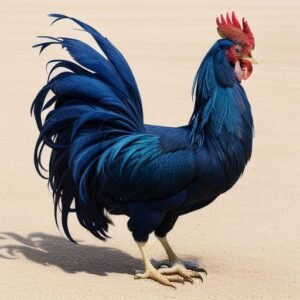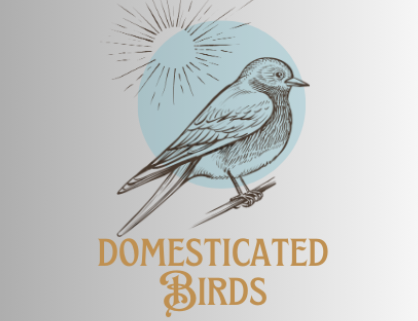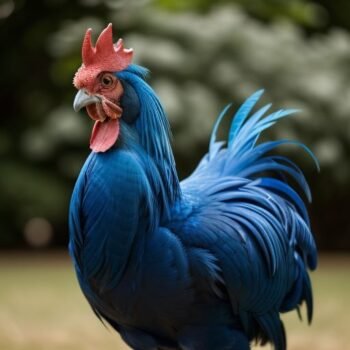Blue Leghorn Rooster Origin
Blue Leghorn roosters were originally bred in Italy during the 19th century, prized for their stunning blue plumage and utility in egg production. These birds quickly became favorites among poultry enthusiasts for their elegant appearance and friendly demeanor. With their origins rooted in Italian agriculture, Blue Leghorn roosters embody a rich history of breeding and refinement, captivating farmers worldwide with their beauty and utility.
History
Blue Leghorn roosters were developed through the efforts of poultry breeders, including renowned scientists such as Reginald Punnett and William Bateson. Punnett and Bateson played significant roles in pioneering selective breeding techniques during the late 19th and early 20th centuries, which laid the foundation for the creation of breeds like the Blue Leghorn. Their research and contributions to genetics and poultry breeding have left a lasting legacy, shaping the development of modern poultry breeds.
Blue Leghorn roosters Appearance
Imagine a Blue Leghorn rooster sauntering through the farmyard, its sleek, blue feathers catching the sunlight and shimmering with a captivating glow. This handsome bird stands tall and proud, with an air of confidence in every step it takes. Its striking appearance is further accentuated by a vibrant red comb crowning its head, adding a dash of color to its majestic presence. With its regal bearing and elegant demeanor, the Blue Leghorn rooster truly stands out as a symbol of beauty and grace in the poultry world.

Are Blue Leghorn Roosters Good Pets?
Yes! They excel as companions for those willing to provide them with the care and space they deserve. Their friendly nature and stunning looks make them a delightful addition to any backyard flock. Whether you’re an experienced poultry keeper or new to raising chickens, a Blue Leghorn rooster can become a beloved member of your family, enriching your life with its personality and presence.
Blue Leghorn Roosters Characteristics
Temperament
Blue Leghorn roosters boast a friendly and sociable disposition that sets them apart from other breeds. Unlike some roosters known for their aggressiveness, Blue Leghorns tend to be gentle and easygoing, making them delightful companions for both humans and fellow poultry.
Are They Friendly with the Hen and the Owner?
Absolutely! Blue Leghorn roosters form strong bonds not only with their hen companions but also with their human caretakers. They display protective instincts towards their flock and enjoy interacting with their owners, often seeking attention and affection during feeding times.
Maintenance Level
When it comes to upkeep, Blue Leghorn roosters are remarkably low-maintenance compared to their counterparts. With proper housing and routine care, they thrive in various environments, making them an excellent choice for both novice and experienced poultry enthusiasts.
Benefits
For Small-Scale Farmer:
Blue Leghorn roosters offer several benefits to small-scale farmers, enhancing farm life in more ways than one:
Egg Production: While Blue Leghorn roosters themselves don’t lay eggs, their selective breeding indirectly contributes to improved egg-laying capabilities in hens. By mating with high-performing hens, they pass on desirable genetic traits associated with increased egg production to their offspring.
Pest Control: Beyond their role in egg production, Blue Leghorn roosters also excel as natural pest controllers. Their foraging instincts make them adept at hunting and consuming pests in the garden or yard, reducing the need for chemical interventions and promoting a healthier environment for crops and other livestock.
Aesthetic Appeal: In addition to their practical benefits, Blue Leghorn roosters add a touch of beauty to any farmstead with their vibrant plumage and graceful demeanor. Their regal appearance enhances the visual appeal of the farm, delighting visitors and adding to the overall ambiance of the property.

For Enthusiast:
Blue Leghorn roosters hold a special place in the hearts of poultry enthusiasts for several reasons:
Breed Standard: These birds exemplify the breed standard with their impeccable conformation and characteristics, making them highly sought-after specimens for breeding and exhibition purposes. Their adherence to the standard ensures consistency and quality in breeding programs, attracting enthusiasts who value pedigree and lineage.
Unique Coloration: One of the most striking features of Blue Leghorn roosters is their distinctive blue plumage, which sets them apart from other breeds in the poultry world. This unique coloration adds aesthetic appeal to any flock and makes them a standout choice for collectors and hobbyists seeking birds with uncommon and eye-catching features.
Exceptional Vigor: Blue Leghorn roosters are renowned for their robust health and vitality, thriving in various climates and environments with minimal care. Their resilience and adaptability make them an excellent choice for enthusiasts seeking birds that can withstand the rigors of backyard farming and exhibition.
How Does Blue Leghorn Rooster Boost Hen’s Egg-Laying Abilities?
Blue Leghorn roosters play a crucial role in enhancing the egg-laying capabilities of hens living alongside them. Through natural mating behaviors, Blue Leghorn roosters ensure genetic diversity within the flock, which is essential for maintaining optimal reproductive health in hens.
Research suggests that the presence of a dominant and genetically superior rooster, such as the Blue Leghorn, can positively influence the hormonal balance and reproductive physiology of hens. This, in turn, can lead to increased egg production and improved egg quality.
Studies have also shown that the social dynamics within a flock, influenced by the presence of a confident and assertive rooster, can reduce stress levels in hens, further enhancing their overall well-being and egg-laying performance.
10 Egg-laying Chicken Breeds For Beginners: Choose The Best One. – Domesticatedbirds.com
Which Hen Matches Best?
When it comes to finding the perfect partner for your Blue Leghorn rooster, the Rhode Island Red hen is a top choice. Here’s why:
Complementary Traits: Imagine the dynamic duo—the Blue Leghorn rooster with its stunning blue plumage and impressive egg-laying abilities, paired with the hardy and nurturing Rhode Island Red hen. Together, they create a balanced flock, each contributing their unique strengths to the mix.
Genetic Compatibility: Research indicates that Blue Leghorn roosters and Rhode Island Red hens are genetically compatible, resulting in offspring with the best qualities of both breeds. These offspring are known for their robust health, vibrant plumage, and exceptional egg-laying capabilities.
Harmonious Flock Dynamics: Rhode Island Red hens are known for their calm and friendly nature, which complements the sociable demeanor of Blue Leghorn roosters. This harmony within the flock promotes stress-free interactions and cooperative breeding behavior, ultimately leading to increased egg production and overall happiness among the birds.

Other Hen Options
While the Rhode Island Red hen is an excellent choice, other breeds such as the Sussex, Plymouth Rock, or Australorp can also complement the qualities of a Blue Leghorn rooster. By carefully selecting the right hen to pair with your rooster, you can create a thriving and harmonious poultry flock that brings joy to your farm.
Blue Leghorn roosters diet/food
Blue Leghorn roosters primarily consume a diet consisting of grains and seeds, supplemented with commercial poultry feed formulated for their nutritional needs. According to research conducted by the University of California Cooperative Extension, poultry nutrition specialists recommend feeding Blue Leghorn roosters a balanced diet containing grains such as corn and oats, along with seeds like sunflower seeds.
This research highlights the importance of providing Blue Leghorn roosters with a diet rich in carbohydrates, protein, and essential nutrients to support their overall health and vitality. Access to clean, fresh water is essential to ensure proper hydration and digestion.
Blue Leghorn rooster Housing Setup
Coop Size: A general rule of thumb is to allocate at least 4 square feet of floor space per bird inside the coop.
Roosting Perches: Install sturdy roosting perches inside the coop, preferably made of natural wood. These perches should be positioned at least 12-18 inches above the ground and spaced about 12 inches apart to accommodate roosting behavior comfortably.
Nesting Boxes: Dedicate nesting boxes for hens if you plan to breed Blue Leghorn roosters. Each nesting box should measure approximately 12x12x12 inches and be filled with clean bedding material such as straw or wood shavings.
Ventilation: Ensure proper ventilation within the coop to maintain good air quality and prevent respiratory issues. Install vents near the roofline to allow for adequate airflow while protecting against drafts.
Lighting: Provide natural or artificial lighting inside the coop to simulate natural daylight hours and encourage egg production. Aim for 14-16 hours of light per day during the laying season, adjusting as needed throughout the year.
Predator Protection: Construct the coop with sturdy materials and secure latches to prevent entry by predators such as raccoons, foxes, and rats. Use hardware cloth to cover windows and ventilation openings, and bury wire mesh around the perimeter to deter digging.
Flooring: Use a solid, easy-to-clean flooring material such as concrete, vinyl, or linoleum inside the coop. Cover the floor with a layer of bedding material like straw or wood shavings to absorb moisture and provide insulation.
Run Area: Allow Blue Leghorn roosters access to an outdoor run area during the day for exercise, foraging, and sunlight exposure. Ideally, the run should provide at least 10 square feet of space per bird and be enclosed with poultry wire to prevent escape and protect against predators.
Pet bird paradise: Images videos and articles on pet birds including chickens.
Fun Facts
Nature’s Gourmet Hunters: Blue Leghorn roosters are the epicureans of the barnyard, renowned for their culinary prowess in foraging. With a discerning eye for delectable treats and an expert nose for the juiciest insects, these birds turn every stroll into a gourmet adventure.
Feathered Resilience: Don’t be fooled by their elegant appearance—Blue Leghorn roosters are the tough guys of the coop. From scorching summers to frosty winters, these resilient birds take Mother Nature’s challenges in stride, proving that strength comes in all shades of blue.
Genetic Marvels: The stunning blue plumage of Blue Leghorn roosters isn’t just a happy accident—it’s a genetic masterpiece! Thanks to a unique mutation, these birds boast a one-of-a-kind color palette that’s the envy of the poultry world. It’s not just fashion—it’s science in style!
Pros and cons of Blue Leghorn rooster
Pros
- Blue Leghorn roosters are admired for their stunning appearance.
- These roosters exhibit a friendly and sociable temperament.
- They have relatively low maintenance requirements compared to other breeds.
- Roosters themselves do not lay eggs; instead, they fertilize eggs laid by hens for breeding purposes.
Cons
- Can be noisy, especially during the morning hours.
- May exhibit territorial behavior, especially around other roosters.
- Require adequate space and housing to thrive.
Summary
In summary, Blue Leghorn roosters are prized for their stunning appearance and friendly demeanor. They enhance the overall egg-laying capacity of a flock by fertilizing eggs laid by hens. With their sociable nature, they foster positive relationships within the flock and with their human caretakers. Their low maintenance needs make them ideal for both novice and experienced poultry keepers. Blue Leghorn roosters not only add aesthetic beauty to any farm but also contribute to the productivity and harmony of the flock, making them valued members of the poultry community.
Are blue Leghorn roosters aggressive?
Blue Leghorn roosters generally exhibit sociable and docile behavior, with occasional territorial tendencies. They're known to be friendly towards humans and other poultry members.
What is the appearance of blue Leghorn rooster?
Blue Leghorn roosters boast a stunning appearance, featuring sleek blue feathers that shimmer in the sunlight and a distinctive red comb atop their heads, adding elegance to any flock.
How big do the Leghorn rooster get?
Leghorn roosters typically reach a moderate size, growing to around 6 to 8 pounds on average, making them manageable for most poultry enthusiasts.
Are Leghorn roosters loud?
While Leghorn roosters can be loud, especially during the morning hours, their vocalizations are generally manageable and may vary from bird to bird.
How do you tell if my Leghorn is a rooster?
Distinguishing a Leghorn rooster from a hen can be done by observing physical traits such as comb size and color, feather patterns, and behavior. Roosters typically have larger, more brightly colored combs, thicker leg bones, and assertive behavior.
What is the appearance and speciality of blue-breasted brown Leghorn rooster?
Blue-breasted Brown Leghorn roosters are prized for their unique combination of rich brown plumage with blue accents on their chests, valued for both their beauty and egg-laying capabilities.
Are blue-red Leghorn good roosters?
Blue-red Leghorn roosters are renowned for their stunning blue plumage with red accents, making them visually striking birds. They are considered good roosters for their beauty and productive egg-laying capabilities.


На займы ру вы можете оформить займ всего за пару кликов. Микрозаймы на выгодных условиях доступны в любое время. Оформите кредитную карту онлайн на выгодных условиях и получите финансовой свободой. Не ждите, действуйте! Оформить микрозайм можно без лишних вопросов. Узнайте больше на https://ozaim.ru/mikrozajmy-onlajn/.
Impressive posts! My blog UY8 about Thai-Massage also has a lot of exclusive content I created myself, I am sure you won’t leave empty-handed if you drop by my page.
Does your blog have a contact page? I’m having problems locating it but, I’d like to shoot you an email. I’ve got some ideas for your blog you might be interested in hearing. Either way, great site and I look forward to seeing it expand over time.